On May 25 of 2017, the families of seven MIA’s filed a lawsuit in Federal Court demanding the return of the remains of their missing family members whom they believed were buried as Unknowns in the Manila American Cemetery. The lead plaintiff in this litigation was John Patterson, Nephew of 1LT Alexander R. Nininger. He had been researching the case since before most of the government experts were born.
”READ_MORE”
The lead expert for the government was Gregory Kupsky, the historian who had prepared the 2012 summary noting that the only eyewitness had placed the burials at a location south of the river where the Abucay Cemetery was located and from where the X-1130/X-4685 remains had been recovered.
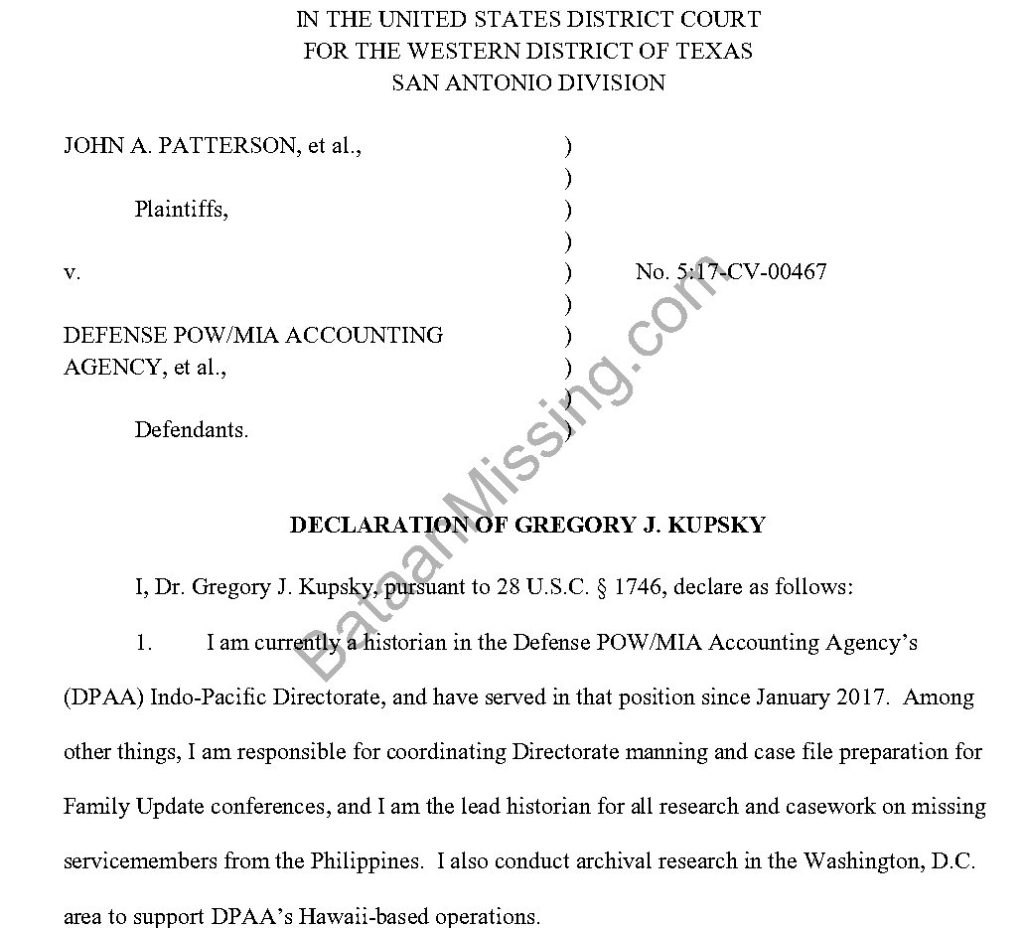

Mr. Kupsky stated that X-1130 came from Grave No. 9 in the Abucay Cemetery
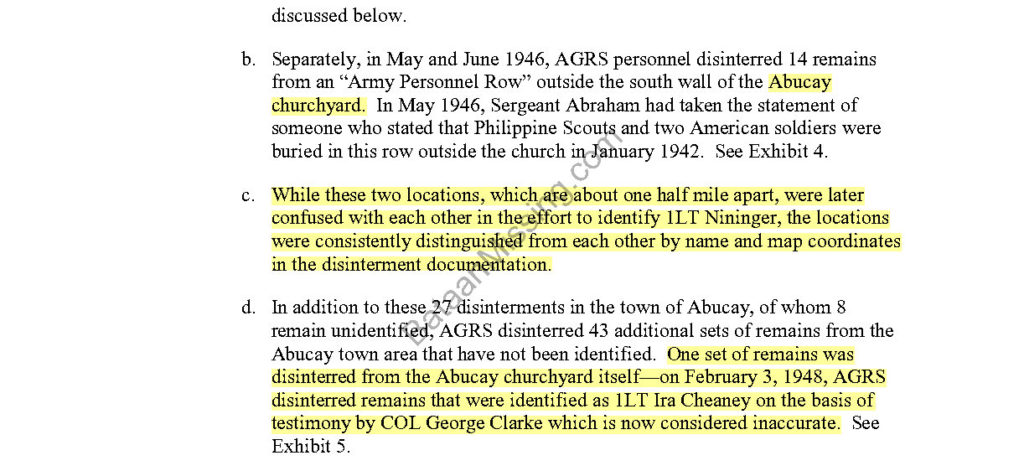
Mr. Kupsky stated that the Abucay Churchyard and Abucay Cemetery were often confused with each other. He further stated that remains identified as 1LT Cheaney were disinterred from the Churchyard on the basis of Clarke’s information.


Mr. Kupsky’s opinion was that COL Clarke’s information was the primary basis for the AGRS to associate the X-1130 remains with 1LT Nininger in that COL Clarke placed the burial in Grave #9 of the Abucay Churchyard and X-1130 was recovered from Grave #9 in the nearby Abucay Cemetery.

Mr. Kupsky is unclear as to when X-1130 was first associated with 1LT Nininger. He thinks the Report of Internment form was used as a worksheet and information was added as it became available.

Mr. Kupsky “suggests” that the “attached letter” referenced on the X-1130 Report of Interment was COL Clarke’s information as provided in a letter from the Nininger and other families.

Mr. Kupsky assumes without evidence that the “attached letter” was based on COL Clarke’s information and there was no other information identifying X-1130. He completely neglects to mention that COL Clarke’s information had been totally discredited both because Clarke had not been present at the burials and that multiple excavations of the churchyard had proven it to be incorrect.
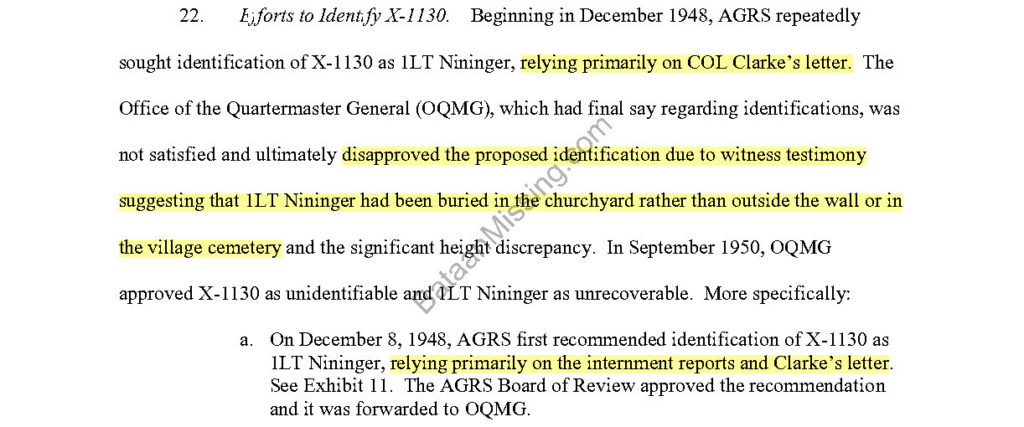
There is no evidence to suggest that AGRS relied primarily on COL Clarke’s letter as suggested by Mr. Kupsky. The AGRS recommendation explained that they actually discounted COL Clarke’s information because it had been found to contain errors as to other burial locations.
Mr. Kupsky’s 2017 declaration did not mention the eyewitness, Major Francis, or that he placed the burial location south of the river opposite the church. Neither did he mention that the Abucay Churchyard had been repeatedly and thoroughly excavated.
The government has always insisted that their objection to exhumation of a grave is their belief in the “sanctity of the grave” and that once interred the remains should not be disturbed.
Many of the Unknowns recovered from Bataan have been repeatedly interred and disinterred. First from their grave on Bataan, then moved to a central cemetery such as Manila #2, then Manila Mausoleum then the Fort McKinley cemetery (now Manila American Cemetery managed by ABMC). Then, at the Manila American Cemetery, Unknowns were often disinterred from the back row of a plot to fill an empty grave at the front of a plot. All for the convenience of the government. So much for the sanctity of the grave objection.
The government wasn’t so concerned about the sanctity of the grave in 2017 when they broke open multiple tombs in the Abucay Churchyard with no more evidence than an internet post by an anonymous person.
A few months after the government was sued by the families, they undertook an ill-conceived project to find the remains of 1LT Nininger in hopes of making the lawsuit moot and getting themselves off the hook. Not being real good at original thinking, they were still convinced that he had been buried in the Abucay Churchyard. Neither the fact that it had been repeatedly excavated nor that the source of the information had been totally discredited, deterred them. They had a solid lead this time. No less an authority than FindAGrave.com told them exactly where to look.
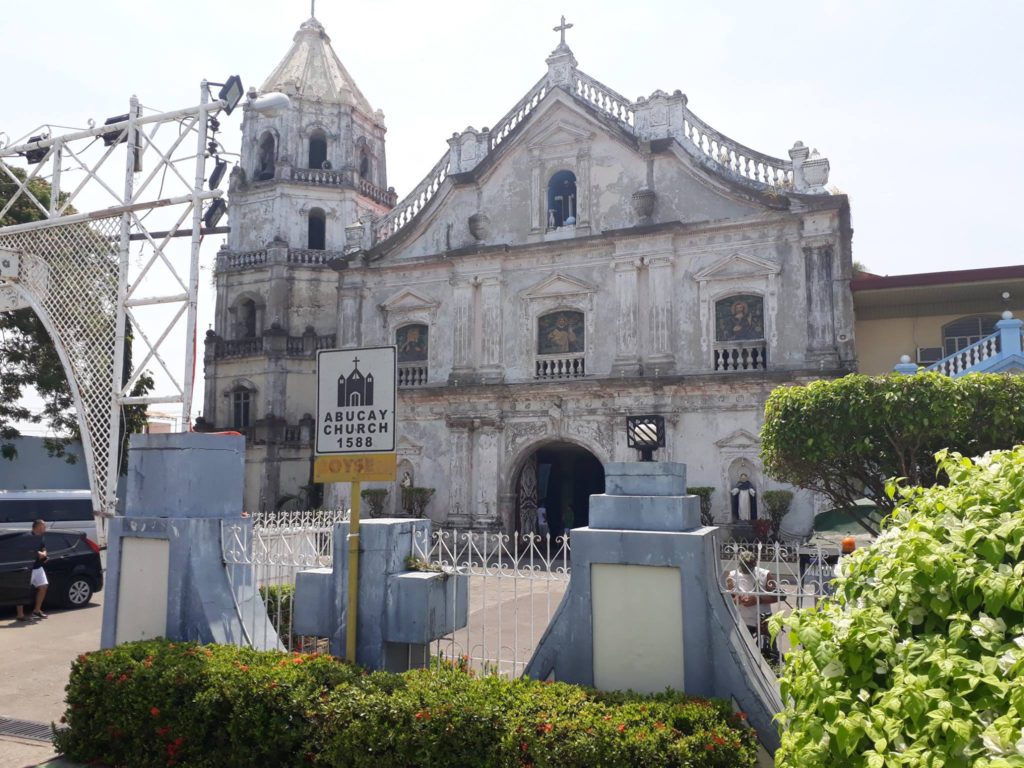
DPAA sprung in to action when they were alerted to a Findagrave.com post by a member using the handle “Anonymous” that 1LT Nininger was buried in a tomb in the Abucay Churchyard. The basis for the post was a plaque on the tomb identifying it as the grave of Alexander Ramsey Nininger, Jr.

Sparing no expense, DPAA broke open five above ground tombs in the Abucay Churchyard. The net result of their efforts was to disturb the graves of some local citizens interred there. Apparently, you just can’t rely on those anonymous plaques anymore.
Here is DPAA’s report of their investigation of the tomb.
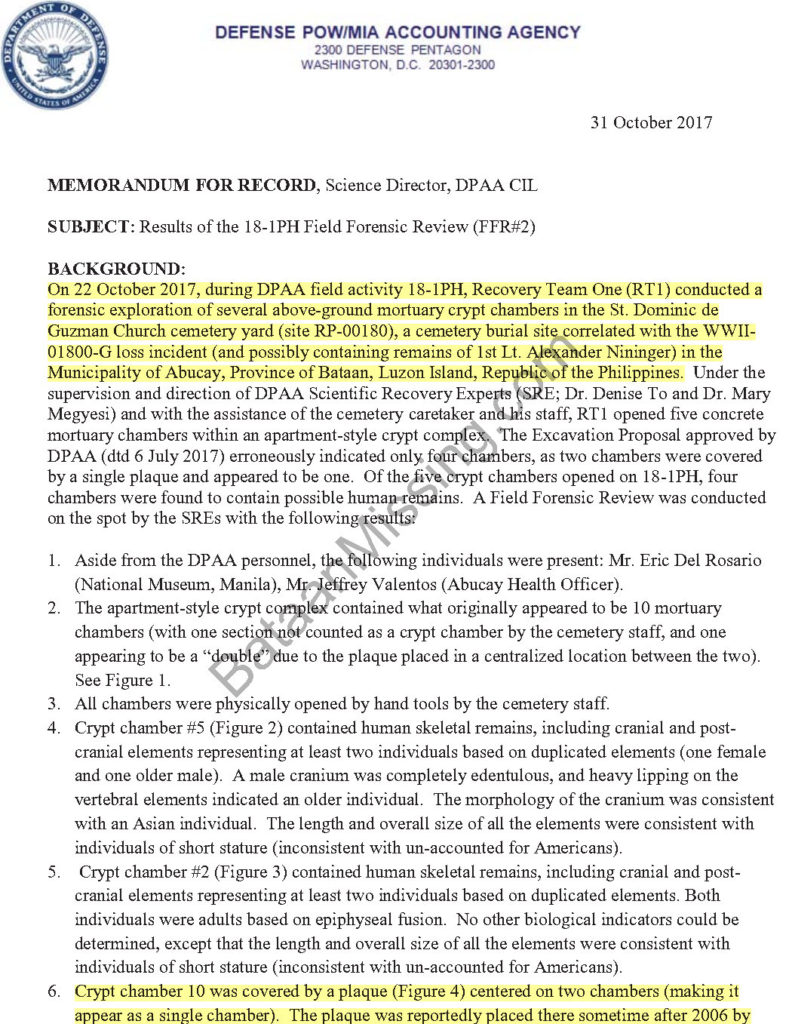


We’re not republishing the photos of the human remains recovered from these tombs as none of them belonged to Nininger. The only thing proved by this boondogle was that the government shouldn’t argue about sanctity of the grave because that is an empty phrase to them.
So what do we know at this point about the burial of 1LT Alexander Nininger –
- The gravedigger said he buried five Americans in the Abucay Cemetery.
- Other officers interviewed state that the deputy commander of the medical detachment, Major Francis, would have been present for Nininger’s burial.
- Major Francis said that Nininger was buried south of the river where the Abucay Cemetery is located.
- The government’s lead expert, Gregory Kupsky is aware of Major Francis’ information, but is careful not to mention him in his 2017 court declarations.
- Major Francis passed away several years ago without ever being interviewed concerning his knowledge of the burials, but his letters survive.
- Remains X-1130/X-4685 were recovered from the Abucay Cemetery.
- The AGRS command repeatedly insisted that X-1130/X-4685 should be identified as 1LT Nininger.
- The Memorial Division in Washington repeatedly disapproved the recommendations because of (COL Clarke’s) discredited information.
- COL Clarke’s information had been repeatedly found to be incorrect.
- The government expert relies on unsubstantiated assumptions to avoid examining X-1130/X-4685. At one point he even states that those remains were recovered from the churchyard rather than the cemetery.
- Colonel George S. Clarke, the disgraced former commander of the 57th Infantry Rgt reported that 1LT Nininger had been buried in Soldiers Row Grave #9 of the Abucay Churchyard.
- Colonel Clarke was not present when Nininger was buried and the source of his information is unknown
- The Abucay Churchyard has no area known as Soldiers Row.
- The Abucay Churchyard had been thoroughly excavated multiple times without result. The remains of only two Americans were recovered from these excavations, Captain H.A. McCurdy and X-3431/X-1671 BTB 1LT John C. Compton both of whom had died at Abucay Hacienda.
- There was a row of graves of soldiers buried outside the church wall. Grave #9 in this row was identified as Philippine Scout PFC Tranquilino Beles, 6738585, by means of an identification tag. (So Nininger could not have been buried in grave #9 at the churchyard because someone else was found to be in it.)
- X-1130/X-4685 was recovered from the Abucay Cemetery Soldiers Row Grave #9.
- The remains of Lt’s Nininger, Compton, Maynard, Green and Wilson have never been identified.
Perhaps just as important is what we don’t know –
- It is unknown why Colonel Clarke would place the location of Nininger’s burial as Abucay Churchyard Soldiers Row #9 since no such location existed, but even Mr. Kupsky admits that the cemetery and churchyard locations were often confused.
- It is unknown what evidence the AGRS relied upon in determining that 1LT Nininger was buried in Grave #9 of the Abucay Cemetery.
- Why did the government’s expert neglect to mention that COL Clarke’s information had been thoroughly discredited or that the only known witness to the burial placed it south of the river.
- Why did the government’s expert assume without evidence that “attached letter” referenced in the X-1130 report of interment contained Clarke’s information and that was the basis for determining that grave 9 contained Nininger’s remains.
There were only two reported locations for the burial of 1LT Nininger, the cemetery and the churchyard. The churchyard had been thoroughly excavated by multiple teams of searchers. There was actually an eyewitness who placed the burial of 1LT Nininger in the cemetery, but the Army had diligently avoided interviewing that witness or examining the X-1130 remains.
Prior to the court’s decision, the government agreed to disinter the graves which the other plaintiff families asserted held the remains of their loved ones. Due to known commingling and conflicting records, there were a total of forty-one graves to be disinterred.
Cabanatuan POW Camp Grave 407 – 9
Cabanatuan POW Camp Grave 704 – 8
Cabanatuan POW Camp Grave 717 – 14
Cabanatuan POW Camp Grave 804 – 4
Colonel Loren Stewart – 3
Brig General Guy Fort – 3
TOTAL GRAVES DISINTERRED – 41
While the government “voluntarily disinterred” – or at least they had not yet been ordered to disinter – forty-one graves to resolve the other six cases. And despite the overwhelming evidence that 1LT Nininger and others were buried in the Abucay Cemetery, the government continues to insist that 1LT Alexander Nininger is buried in a location they have repeatedly investigated without finding anything. Even after the embarrassment of breaking open five more graves with negative results, the government still refuses to further investigate the X-1130/X-4685 remains. One has to ask why?
”READ_LESS”
